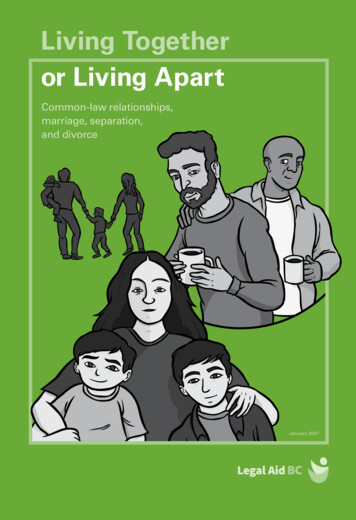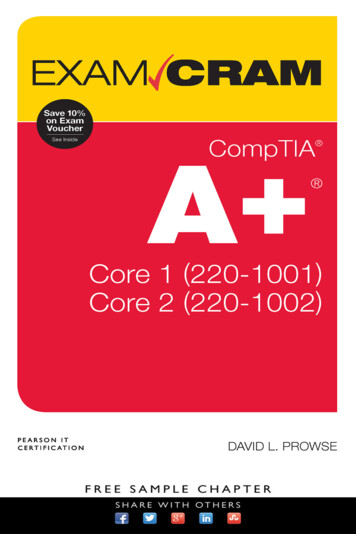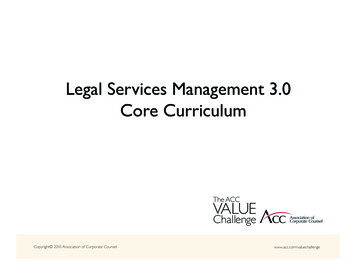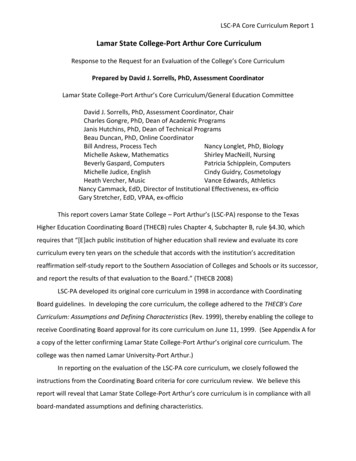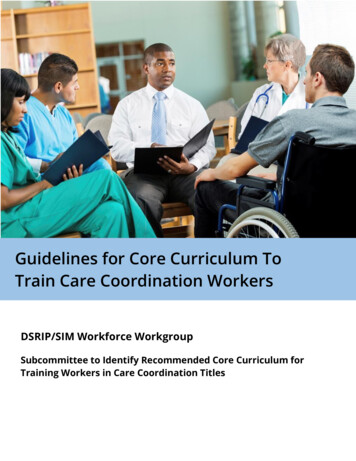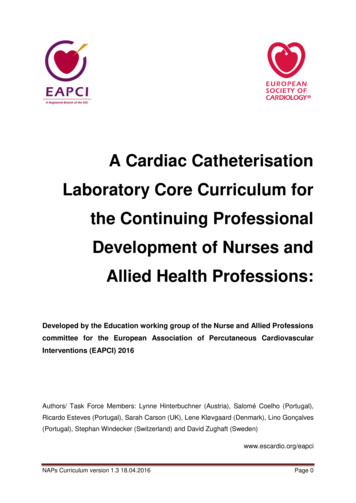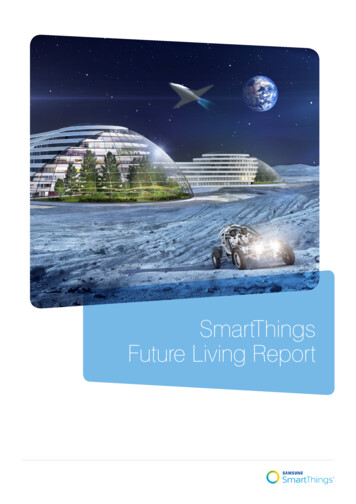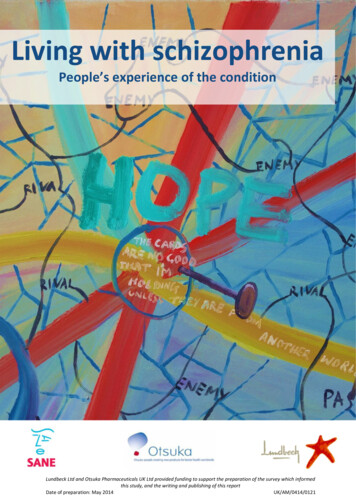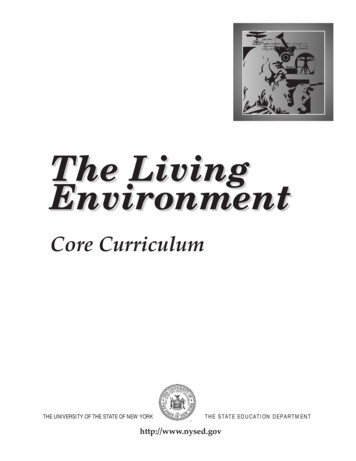
Transcription
The LivingEnvironmentCore CurriculumTHE UNIVERSITY OF THE STATE OF NEW YORKTHE STATE EDUCATION DEPARTMENThttp://www.nysed.gov
THE UNIVERSITY OF THE STATE OF NEW YORKRegents of The UniversityCARL T. HAYDEN, Chancellor, A.B., J.D. .ElmiraDIANE O’NEILL MCGIVERN, Vice Chancellor, B.S.N., M.A., Ph.D. .BaysideJ. EDWARD MEYER, B.A., LL.B. .ChappaquaR. CARLOS CARBALLADA, Chancellor Emeritus, B.S. .RochesterADELAIDE L. SANFORD, B.A., M.A., P.D. .HollisSAUL B. COHEN, B.A., M.A., Ph.D. .New RochelleJAMES C. DAWSON, A.A., B.A., M.S., Ph.D. .PeruROBERT M. BENNETT, B.A., M.S. .TonawandaROBERT M. JOHNSON, B.S., J.D. .Lloyd HarborPETER M. PRYOR, B.A., LL.B., J.D., LL.D. .AlbanyANTHONY S. BOTTAR, B.A., J.D. .SyracuseMERRYL H. TISCH, B.A., M.A. .New YorkHAROLD O. LEVY, B.S., M.A. (Oxon.), J.D. .New YorkENA L. FARLEY, B.A., M.A., Ph.D. .BrockportGERALDINE D. CHAPEY, B.A., M.A., Ed.D. .Belle HarborRICARDO E. OQUENDO, B.A., J.D. .BronxPresident of The University and Commissioner of EducationRICHARD P. MILLSChief Operating OfficerRICHARD H. CATEDeputy Commissioner for Elementary, Middle, Secondary, and ContinuingEducationJAMES A. KADAMUSAssistant Commissioner for Curriculum, Instruction, and AssessmentROSEANNE DEFABIOThe State Education Department does not discriminate on the basis of age, color, religion, creed, dis ability, marital status, veteran status, national origin, race, gender, genetic predisposition or carrier sta tus, or sexual orientation in its educational programs, services, and activities. Portions of this publica tion can be made available in a variety of formats, including braille, large print or audio tape, uponrequest. Inquiries concerning this policy of nondiscrimination should be directed to the Department’sOffice for Diversity, Ethics, and Access, Room 152, Education Building, Albany, NY 12234.
CONTENTSAcknowledgments . . . . . . . . . . . . . . . . . . . . . . . . . . . .ivCore Curriculum . . . . . . . . . . . . . . . . . . . . . . . . . . . . . .1Preface . . . . . . . . . . . . . . . . . . . . . . . . . . . . . . . . . . .3Standard 1 . . . . . . . . . . . . . . . . . . . . . . . . . . . . . . . . .5Key Idea 1 . . . . . . . . . . . . . . . . . . . . . . . . . . . . . . .5Key Idea 2 . . . . . . . . . . . . . . . . . . . . . . . . . . . . . . .6Key Idea 3 . . . . . . . . . . . . . . . . . . . . . . . . . . . . . . .7Standard 4 . . . . . . . . . . . . . . . . . . . . . . . . . . . . . . . . .9Key Idea 1 . . . . . . . . . . . . . . . . . . . . . . . . . . . . . . .9Key Idea 2 . . . . . . . . . . . . . . . . . . . . . . . . . . . . . .11Key Idea 3 . . . . . . . . . . . . . . . . . . . . . . . . . . . . . .13Key Idea 4 . . . . . . . . . . . . . . . . . . . . . . . . . . . . . .14Key Idea 5 . . . . . . . . . . . . . . . . . . . . . . . . . . . . . .15Key Idea 6 . . . . . . . . . . . . . . . . . . . . . . . . . . . . . .17Key Idea 7 . . . . . . . . . . . . . . . . . . . . . . . . . . . . . .19Appendix ALiving Environment—Laboratory Checklist . . . . . . .21Living Environmentiii
ACKNOWLEDGMENTSThe State Education Department acknowledges the assistance of teachers and school administrators from acrossNew York State and the Biology Mentor Network. In particular, the State Education Department would like to thank:Alan AscherSouth Shore High SchoolCandy BanduraNiskayuna High SchoolJohn BartschAmsterdam High SchoolDave BauerAlden Central High SchoolMarilou BebakNardin Academy High SchoolMary ColvardCobleskill High SchoolMarianita DamariOffice of Brooklyn High SchoolsLee DrakeFinger Lakes Community CollegeMichael DuPréRush-Henrietta Central School DistrictRick HallmanOffice of Queens High SchoolsBarbara HobartConsultant, Orleans-Niagara BOCESLinda HobartFinger Lakes Community CollegeSusan HoffmireVictor High SchoolSusan HoltWilliamsville East High SchoolDan JohnsonCicero-North Syracuse High SchoolSandra LatourelleSUNY Plattsburgh, Clinton Community CollegeJohn McGrathBaldwin High SchoolLaura MaitlandBellmore-Merrick High SchoolsDonna MooreCornell Agriculture Education OutreachRobert Petingi(formerly) Leadership Secondary SchoolBarbara PoseluznyWoodside, NYCarl RaabBoard of Education, New York CityDeAnna RobersonNew York CitySylvia ThomsonMonroe Community CollegeBruce TullochBethlehem Central High SchoolJoyce ValentiWindham-Ashland-Jewett High SchoolKathy YlvisakerNiskayuna High SchoolThe Living Environment Core Curriculum was reviewed by many teachers and administrators across the State including Coordinating and Regional Biology Mentors. The State Education Department thanks those individuals whoprovided feedback both formally and informally.In addition, the following individuals responded to a joint request by the Science Teachers Association of New YorkState and the State Education Department to review the document from their perspectives as scientists, science professors, and/or science education professors. Thanks go to Mary Colvard for organizing this effort.Rita CalvoCornell University, Ithaca, NYMarvin DrugerSyracuse University, Syracuse, NYRita HootsDavis, CAPaul DeHart HurdPalo Alto, CAJay LabovNational Research Council, Washington, DCWilliam LeonardClemson University, Clemson, SCRoss McIntyreCornell University, Ithaca, NYCheryl MasonSan Diego State University, San Diego, CAJoseph NovakTaunton, MAJohn PenickNorth Carolina State University, Raleigh, NCBarbara SchulzLakeside Upper School, Seattle, WAThe project manager for the development of The Living Environment Core Curriculum was Elise Russo, Associate inScience Education, with content and assessment support provided by Mary Oliver, Associate in Educational Testing.Diana K. Harding, Associate in Science Education, provided additional support. Special thanks go to Jan Christmanfor technical expertise and to John Bartsch, Amsterdam High School, for preliminary drafts of the document.ivLiving Environment
The LivingEnvironmentCore Curriculum
2Living Environment
PREFACEThe Living Environment Core Curriculum has been written to assist teachers and supervisors as they preparecurriculum, instruction, and assessment for the LivingEnvironment component of Standard 4 of the NewYork State Learning Standards for Mathematics, Science,and Technology. This standard states: “Students willunderstand and apply scientific concepts, principles,and theories pertaining to the physical setting and living environment and recognize the historical development of ideas in science.” This Core Curriculum is anelaboration of the science content of the mathematics,science, and technology learning standards documentand its Key Ideas and Performance Indicators. KeyIdeas are broad, unifying, general statements of whatstudents need to know. The Performance Indicators foreach Key Idea are statements of what students shouldbe able to do to provide evidence that they understandthe Key Idea. This Core Curriculum presents MajorUnderstandings that give more specific detail to theconcepts underlying the Performance Indicators inStandard 4.In addition, the Scientific Inquiry portion of Standard 1has been elaborated to highlight those skills necessaryto allow students to test their proposed explanations ofnatural phenomena by using the conventional techniques and procedures of scientists. The concepts andskills identified in the introduction and MajorUnderstandings for each Key Idea in this CoreCurriculum will provide the material from whichRegents examination items will be developed.Occasionally, examples are given in an effort to clarifyinformation. These examples are not inclusive lists;therefore, teachers should not feel limited by them.This Core Curriculum is not a syllabus. It addressesonly the content and skills to be assessed at the commencement level by the Living Environment Regentsscience examination. The Core Curriculum has beenprepared with the assumption that the content, skills,and vocabulary as outlined in the Learning Standardsfor Mathematics ,Science, and Technology at the elementary and intermediate levels have been taught previously. Work in grades 9-12 must build on the knowledge, understanding, and ability to do science thatstudents have acquired in their earlier grades. This is acore for the preparation of high school curriculum,instruction, and assessment, the final stage in a K-12Living Environmentcontinuum of science education. The lack of detail inthis core is not to be seen as a shortcoming. Rather, thefocus on conceptual understanding in the core is consistent with the approaches recommended in theNational Science Education Standards and Benchmarks ofScience Literacy: Project 2061. It is essential that instruction focus on understanding important relationships,processes, mechanisms, and applications of concepts.Far less important is the memorization of specializedterminology and technical details. Future assessmentswill test students’ ability to explain, analyze, and interpret biological processes and phenomena more thantheir ability to recall specific facts. It is hoped that thegeneral nature of these statements will encourage theteaching of science for this understanding, instead offor memorization. The following question has beenasked for each Key Idea: What do students need toknow to have science literacy within that broad theme?The general nature of the Major Understandings in thiscore will also allow teachers more flexibility, makingpossible richer creativity in instruction and greatervariation in assessment than a more explicit syllabuswould allow.The order of presentation and numbering of all statements in this document are not meant to indicate anyrecommended sequence of instruction. Ideas have notbeen prioritized, nor have they been organized in anymanner to indicate time allotments. Many of the MajorUnderstandings in this document are stated in a generalrather than specific way. It is expected, however, thatteachers will provide examples and applications in theirteaching/learning strategies to bring about understanding of the major concepts involved. Teachers are encouraged to help students find and elaborate conceptualcross-linkages that interconnect many of the LivingEnvironment Key Ideas to each other and to other mathematics, science, and technology learning standards.The courses designed using this Core Curriculum areexpected to prepare students to explain, both accurately and with appropriate depth, the most importantideas about our living environment. Students, inattaining scientific literacy, ought to be able to generatesuch explanations, in their own words, by the timethey graduate and also long after they have completedtheir high school education. The science educatorsthroughout New York State who collaborated on the3
writing of this core fervently hope that this goal isrealized in the years ahead.Laboratory Requirements: Critical to understandingscience concepts is the use of scientific inquiry todevelop explanations of natural phenomena. Therefore,as a prerequisite for admission to the Regents examination in the Living Environment, students must havesuccessfully completed 1200 minutes of laboratoryexperience with satisfactory written reports for eachlaboratory investigation.4It is expected that laboratory experiences will providethe opportunity for students to develop the scientificinquiry techniques in Standard 1, the use of information systems as outlined in Standard 2, the interconnectedness of content and skills and the problem-solving approaches in Standards 6 and 7, and the skillsidentified on the laboratory skills checklist found inAppendix A.Living Environment
STANDARD 1Students will use mathematical analysis, scientific inquiry, and engineering design, as appropriate, to posequestions, seek answers, and develop solutions.Science relies on logic and creativity. Science is both a body of knowledge and a way of knowing—an intellectualand social process that applies human intelligence to explaining how the world works. Scientific explanations aredeveloped using both observations (evidence) and what people already know about the world (scientific knowledge). All scientific explanations are tentative and subject to change. Good science involves questioning, observingand inferring, experimenting, finding evidence, collecting and organizing data, drawing valid conclusions, andundergoing peer review. Understanding the scientific view of the natural world is an essential part of personal,societal, and ethical decision making. Scientific literacy involves internalizing the scientific critical attitude so that itcan be applied in everyday life, particularly in relation to health, commercial, and technological claims. Also seeLaboratory Checklist in Appendix A.Key Idea 1:The central purpose of scientific inquiry is to develop explanations of natural phenomena in a continuing andcreative process.PERFORMANCEINDICATOR 1.1Elaborate on basic scientific and personal explanations of natural phenomena, and developextended visual models and mathematical formulations to represent one’s thinking.Major Understandings1.1a Scientific explanations are built by combining evidence that can be observed withwhat people already know about the world.1.1b Learning about the historical development of scientific concepts or about individuals who have contributed to scientific knowledge provides a better understanding ofscientific inquiry and the relationship between science and society.1.1c Science provides knowledge, but values are also essential to making effective andethical decisions about the application of scientific knowledge.PERFORMANCEINDICATOR 1.2Hone ideas through reasoning, library research, and discussion with others, includingexperts.Major Understandings1.2a Inquiry involves asking questions and locating, interpreting, and processinginformation from a variety of sources.1.2b Inquiry involves making judgments about the reliability of the source andrelevance of information.Living Environment5
PERFORMANCEINDICATOR 1.3Work toward reconciling competing explanations; clarify points of agreement anddisagreement.Major Understandings1.3a Scientific explanations are accepted when they are consistent with experimentaland observational evidence and when they lead to accurate predictions.1.3b All scientific explanations are tentative and subject to change or improvement.Each new bit of evidence can create more questions than it answers. This leads toincreasingly better understanding of how things work in the living world.PERFORMANCEINDICATOR 1.4Coordinate explanations at different levels of scale, points of focus, and degrees of complexity and specificity, and recognize the need for such alternative representations of the naturalworld.Major Understandings1.4a Well-accepted theories are ones that are supported by different kinds of scientificinvestigations often involving the contributions of individuals from differentdisciplines.Key Idea 2:Beyond the use of reasoning and consensus, scientific inquiry involves the testing of proposed explanationsinvolving the use of conventional techniques and procedures and usually requiring considerable ingenuity.PERFORMANCEINDICATOR 2.1Devise ways of making observations to test proposed explanations.PERFORMANCEINDICATOR 2.2Refine research ideas through library investigations, including electronic informationretrieval and reviews of the literature, and through peer feedback obtained from review anddiscussion.Major Understandings2.2a Development of a research plan involves researching background information andunderstanding the major concepts in the area being investigated. Recommendations formethodologies, use of technologies, proper equipment, and safety precautions shouldalso be included.6Living Environment
PERFORMANCEINDICATOR 2.3Develop and present proposals including formal hypotheses to test explanations; i.e., predictwhat should be observed under specific conditions if the explanation is true.Major Understandings2.3a Hypotheses are predictions based upon both research and observation.2.3b Hypotheses are widely used in science for determining what data to collect and asa guide for interpreting the data.2.3c Development of a research plan for testing a hypothesis requires planning to avoidbias (e.g., repeated trials, large sample size, and objective data-collection techniques).PERFORMANCEINDICATOR 2.4Carry out a research plan for testing explanations, including selecting and developing techniques, acquiring and building apparatus, and recording observations as necessary.Key Idea 3:The observations made while testing proposed explanations, when analyzed using conventional and inventedmethods, provide new insights into natural phenomena.PERFORMANCEINDICATOR 3.1Use various methods of representing and organizing observations (e.g., diagrams, tables,charts, graphs, equations, matrices) and insightfully interpret the organized data.Major Understandings3.1a Interpretation of data leads to development of additional hypotheses, the formulation of generalizations, or explanations of natural phenomena.PERFORMANCEINDICATOR 3.2Apply statistical analysis techniques when appropriate to test if chance alone explains theresults.PERFORMANCEINDICATOR 3.3Assess correspondence between the predicted result contained in the hypothesis and actualresult, and reach a conclusion as to whether the explanation on which the prediction wasbased is supported.Living Environment7
PERFORMANCEINDICATOR 3.4Based on the results of the test and through public discussion, revise the explanation andcontemplate additional research.Major Understandings3.4a Hypotheses are valuable, even if they turn out not to be true, because they maylead to further investigation.3.4b Claims should be questioned if the data are based on samples that are very small,biased, or inadequately controlled or if the conclusions are based on the faulty, incomplete, or misleading use of numbers.3.4c Claims should be questioned if fact and opinion are intermingled, if adequateevidence is not cited, or if the conclusions do not follow logically from the evidencegiven.PERFORMANCEINDICATOR 3.5Develop a written report for public scrutiny that describes the proposed explanation, including a literature review, the research carried out, its result, and suggestions for furtherresearch.Major Understandings3.5a One assumption of science is that other individuals could arrive at the same explanation if they had access to similar evidence. Scientists make the results of their investigations public; they should describe the investigations in ways that enable others torepeat the investigations.3.5b Scientists use peer review to evaluate the results of scientific investigations and theexplanations proposed by other scientists. They analyze the experimental procedures,examine the evidence, identify faulty reasoning, point out statements that go beyond theevidence, and suggest alternative explanations for the same observations.8Living Environment
STANDARD 4Students will understand and apply scientific concepts, principles, and theories pertaining to the physicalsetting and living environment and recognize the historical development of ideas in science.Key Idea 1:Living things are both similar to and different from each other and from nonliving things.Living things are similar in that they rely on many of the same processes to stay alive, yet are different in the waysthat these processes are carried out.Nonliving things lack certain features of living organisms, such as the ability to maintain a cellular organization,carry out metabolic processes while maintaining internal stability (homeostasis), and pass on hereditary information through reproduction.In most biological respects, humans are like other living organisms. For instance, they are made up of cells likethose of other animals, have much the same chemical composition, have organ systems and physical characteristicslike many others, reproduce in a similar way, carry the same kind of genetic information system, and are part of afood web.The components of living systems, from a single cell to an ecosystem, interact to maintain balance. Different organisms have different regulatory mechanisms that function to maintain the level of organization necessary for life.Diversity is evident and important at all levels of organization—from a single cell to a multicellular organism to anecosystem.PERFORMANCEINDICATOR 1.1Explain how diversity of populations within ecosystems relates to the stability of ecosystems.Major Understandings1.1a Populations can be categorized by the function they serve. Food webs identify therelationships among producers, consumers, and decomposers carrying out eitherautotropic or heterotropic nutrition.1.1b An ecosystem is shaped by the nonliving environment as well as its interactingspecies. The world contains a wide diversity of physical conditions, which creates avariety of environments.1.1c In all environments, organisms compete for vital resources. The linked and changing interactions of populations and the environment compose the total ecosystem.1.1d The interdependence of organisms in an established ecosystem often results inapproximate stability over hundreds and thousands of years. For example, as one population increases, it is held in check by one or more environmental factors or anotherspecies.1.1e Ecosystems, like many other complex systems, tend to show cyclic changes arounda state of approximate equilibrium.1.1f Every population is linked, directly or indirectly, with many others in an ecosystem. Disruptions in the numbers and types of species and environmental changes canupset ecosystem stability.Living Environment9
PERFORMANCEINDICATOR 1.2Describe and explain the structures and functions of the human body at different organizational levels (e.g., systems, tissues, cells, organelles).Major Understandings1.2a Important levels of organization for structure and function include organelles,cells, tissues, organs, organ systems, and whole organisms.1.2b Humans are complex organisms. They require multiple systems for digestion, respiration, reproduction, circulation, excretion, movement, coordination, and immunity.The systems interact to perform the life functions.1.2c The components of the human body, from organ systems to cell organelles, interactto maintain a balanced internal environment. To successfully accomplish this, organismspossess a diversity of control mechanisms that detect deviations and make correctiveactions.1.2d If there is a disruption in any human system, there may be a corresponding imbalance in homeostasis.1.2e The organs and systems of the body help to provide all the cells with their basicneeds. The cells of the body are of different kinds and are grouped in ways that enhancehow they function together.1.2f Cells have particular structures that perform specific jobs. These structures perform the actual work of the cell. Just as systems are coordinated and work together, cellparts must also be coordinated and work together.1.2g Each cell is covered by a membrane that performs a number of important functions for the cell. These include: separation from its outside environment, controllingwhich molecules enter and leave the cell, and recognition of chemical signals. Theprocesses of diffusion and active transport are important in the movement of materialsin and out of cells.1.2h Many organic and inorganic substances dissolved in cells allow necessary chemicalreactions to take place in order to maintain life. Large organic food molecules such asproteins and starches must initially be broken down (digested to amino acids and simple sugars respectively), in order to enter cells. Once nutrients enter a cell, the cell willuse them as building blocks in the synthesis of compounds necessary for life.1.2i Inside the cell a variety of specialized structures, formed from many different molecules, carry out the transport of materials (cytoplasm), extraction of energy from nutrients (mitochondria), protein building (ribosomes), waste disposal (cell membrane), storage (vacuole), and information storage (nucleus).1.2j Receptor molecules play an important role in the interactions between cells. Twoprimary agents of cellular communication are hormones and chemicals produced bynerve cells. If nerve or hormone signals are blocked, cellular communication isdisrupted and the organism’s stability is affected.10Living Environment
PERFORMANCEINDICATOR 1.3Explain how a one-celled organism is able to function despite lacking the levels oforganization present in more complex organisms.Major Understandings1.3a The structures present in some single-celled organisms act in a manner similar tothe tissues and systems found in multicellular organisms, thus enabling them toperform all of the life processes needed to maintain homeostasis.Key Idea 2:Organisms inherit genetic information in a variety of ways that result in continuity of structure and functionbetween parents and offspring.Organisms from all kingdoms possess a set of instructions (genes) that determines their characteristics. Theseinstructions are passed from parents to offspring during reproduction. Students are familiar with simple mechanisms related to the inheritance of some physical traits in offspring. They are now able to begin to understand themolecular basis of heredity and how this set of instructions can be changed through recombination, mutation, andgenetic engineering.The inherited instructions that are passed from parent to offspring exist in the form of a code. This code is contained in DNA molecules. The DNA molecules must be accurately replicated before being passed on. Once thecoded information is passed on, it is used by a cell to make proteins. The proteins that are made become cell partsand carry out most functions of the cell.Throughout recorded history, humans have used selective breeding and other biotechnological methods to produceproducts or organisms with desirable traits. Our current understanding of DNA extends this to the manipulation ofgenes leading to the development of new combinations of traits and new varieties of organisms.PERFORMANCEINDICATOR 2.1Explain how the structure and replication of genetic material result in offspring that resembletheir parents.Major Understandings2.1a Genes are inherited, but their expression can be modified by interactions with theenvironment.2.1b Every organism requires a set of coded instructions for specifying its traits. For offspring to resemble their parents, there must be a reliable way to transfer informationfrom one generation to the next. Heredity is the passage of these instructions from onegeneration to another.2.1c Hereditary information is contained in genes, located in the chromosomes of eachcell. An inherited trait of an individual can be determined by one or by many genes, anda single gene can influence more than one trait. A human cell contains many thousandsof different genes in its nucleus.2.1d In asexually reproducing organisms, all the genes come from a single parent.Asexually produced offspring are normally genetically identical to the parent.2.1e In sexually reproducing organisms, the new individual receives half of the geneticinformation from its mother (via the egg) and half fromits father (via the sperm). Sexuallyproduced offspringoften resemble, but are not identical to, either of their parents.Living Environment11
PERFORMANCEINDICATOR 2.1continued2.1f In all organisms, the coded instructions for specifying the characteristics of theorganism are carried in DNA, a large molecule formed from subunits arranged in asequence with bases of four kinds (represented by A, G, C, and T). The chemical andstructural properties of DNA are the basis for how the genetic information that underlies heredity is both encoded in genes (as a string of molecular “bases”) and replicatedby means of a template.2.1g Cells store and use coded information. The genetic information stored in DNA isused to direct the synthesis of the thousands of proteins that each cell requires.2.1h Genes are segments of DNA molecules. Any alteration of the DNA sequence is amutation. Usually, an altered gene will be passed on to every cell that develops from it.2.1i The work of the cell is carried out by the many different types of molecules itassembles, mostly proteins. Protein molecules are long, usually folded chains madefrom 20 different kinds of amino acids in a specific sequence. This sequence influencesthe shape of the protein. The shape of the protein, in turn, determines its function.2.1j Offspring resemble their parents because they inherit similar genes that code forthe production of proteins that form similar structures and perform similar functions.2.1k The many body cells in an individual can be very different from one another, eventhough they are all descended from a sing
The Living Environment Core Curriculum has been writ-ten to assist teachers and supervisors as they prepare curriculum, instruction, and assessment for the Living Environment component of Standard 4 of the New York State Learning Standards for Mathematics, Scie
